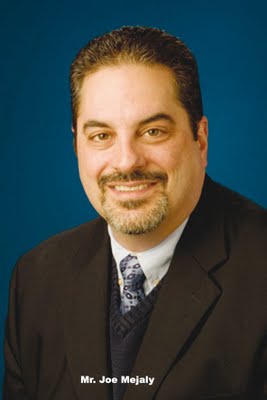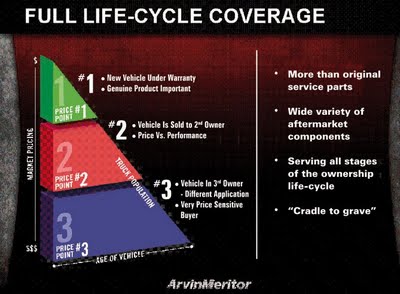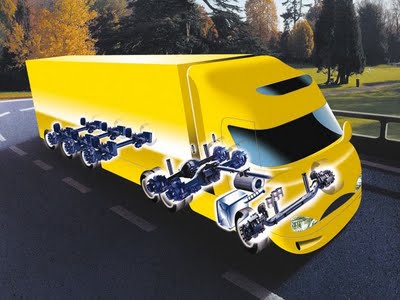 The aftermarket has never been more important to North American truck operators as they strive to maximize life and uptime from their current fleet of trucks and trailers. With an average vehicle age approaching nine years, the fleet manager, with his distribution channel for replacement parts, focuses on quality parts availability and overall life cycle costs, including appropriate parts support, counsel and expertise.
The aftermarket has never been more important to North American truck operators as they strive to maximize life and uptime from their current fleet of trucks and trailers. With an average vehicle age approaching nine years, the fleet manager, with his distribution channel for replacement parts, focuses on quality parts availability and overall life cycle costs, including appropriate parts support, counsel and expertise.
One result of this increased focus on parts is that there are more parts sources today, particularly low-cost suppliers. But with this low cost arises the issue of quality, support, resources, availability and back-up required from a comprehensive parts portfolio. Before and after-the-sale support has never been more sought for and even demanded by fleet operators.
The management team of ArvinMeritor’s Commercial Vehicle Aftermarket business group recognizes distinct trends that are impacting the aftermarket, including fleet operators as well as truck-trailer dealers and distributors.
The following are the six distinct trends impacting the aftermarket:
Total life cycle approach: When a truck operator asks about replacement parts, the simplest advice is to purchase the exact same part spec that came with the vehicle from the factory. Generally, that’s the most reliable rule of thumb.
As they age, trucks and trailers take on new owners and with them new vocations. A vehicle designed for truckload service in the South-East may now be hauling grain over mountain passes in the Pacific Northwest. Commercial vehicles need replacement parts that are suited to how and where they work right now. A component that just “fits” a given make and model may not necessarily meet the customer’s need for performance, longevity, and especially value. Component manufacturers are providing increasingly more assistance with the vocational spec’ing of components. Field representatives have spec’ing software that can help determine which components will deliver the best performance for the way a vehicle is being used at the time of repair.
Component manufacturers are providing increasingly more assistance with the vocational spec’ing of components. Field representatives have spec’ing software that can help determine which components will deliver the best performance for the way a vehicle is being used at the time of repair.
Managing customers who run lean: Dealers and WDs are looking for strategies to sell to cost-conscious customers. One element involves inventory – stocking parts that are low priced but deliver good performance and value. This can include “OEM-approved” parts that are made by a third-party vendor but meet rigorous performance and manufacturing standards set by a reputable OE manufacturer in North America. That OEM may not produce part, but it stands behind it.
Naturally with any replacement parts to maximize vehicles’ uptime is the advantage of offering OEM dealers and WDs quick and ready access to parts inventory at domestic warehousing.
In addition to more prevalent online ordering, many suppliers offer vendor managed inventory (VMI). VMI can automatically generate recommended orders based on mutually agreed upon objectives and information sent by the customer. After the VMI system develops recommended orders, the supplier reviews them and launches the ordering feature. A purchase order is generated and transmitted from the supplier to the customer through the customer’s back-end system.
Another element is education and training. In an age of “buyer beware,” aftermarket parts dealers and WDs can play an increasing role in helping customers understand the increasing number of parts choices that are available and what they trade off when cost-cutting or price is the top priority.
Rise of remanufacturing: Remanufactured truck and trailer components – the product of a disassembly, cleaning, rigorous inspection and qualifying, including necessary replacement, reassembly and testing process – are ideal for customers who want performance, service life and warranty support without the cost associated with a new component.
Parts buying decisions shift as the vehicle gets older. The second, third and fourth owners may have different priorities than the original. For instance, as illustrated on the chart, truck operators move to price point products, and eventually heavy use of remanufactured components, to assure high quality.
Remanufacturing differs from rebuilding or repairing, in that the part is disassembled, cleaned, inspected, and any worn components are replaced. The part is then re-assembled to the same tolerances as the original. The result is an exact fit, with no modifications necessary for vehicle installation. The component is designed and tested to match the performance and fit of the original at a lower cost than a completely new unit.
Remanufacturing also provides the environmental benefit of extending the productive life of a part that might otherwise be scrapped. In 2008, over 60 million pounds of steel were recycled and remanufactured by ArvinMeritor.
Information services: The successes of online retailers like Amazon.com have raised expectations for anyone who uses the internet to compare products and place orders. Many suppliers, including ArvinMeritor, have online catalogs and ordering systems. In our case, XpresswayPlus.com enables customers to check product availability, place orders, check the status of a delivery, print invoices, view in-depth technical information, and see enlarged views of products and assemblies. It provides dealers and independent shops alike with equal access to general service and repair information for ArvinMeritor products.
Information services has also contributed to the company’s ability to step up customer service with a five-star Call Center that provides first-call resolution, follow-up resolution within 24 hours, order board management, and e-commerce. Technology is enabling suppliers to offer more convenient and cost-effective training. ArvinMeritor’s Blended Learning Program is an example of using technology to integrate self-guided online learning, virtual classroom webinars, and on-site instruction.
Technology is enabling suppliers to offer more convenient and cost-effective training. ArvinMeritor’s Blended Learning Program is an example of using technology to integrate self-guided online learning, virtual classroom webinars, and on-site instruction.
The appeal of all-makes: Ten years ago, there were incentives for fleets to consolidate their vehicle purchases with one vehicle manufacturer. Today’s truck buyers serve more markets, offer more services and support more applications than ever before.
It’s not practical to maintain an inventory of genuine replacement parts that spans the multiple brands of today’s mixed fleet. By implementing the concept of all-makes parts, truck operators can enjoy the benefits of “one-stop shopping” while dealers and distributors can streamline inventory and capture more business regardless of a fleet’s brand composition. Consider the intrinsic and pragmatic value of one phone number, one center of expertise, one website, and one trusted in-the-fiel
d representative. The all-makes difference is in the bottomline.
The risk of imitation parts: There will always be a group of customers who buy on price alone. However, as a dealer or distributor, it’s important to be wary of will-fit parts that don’t deliver the consistent and reliable performance that customers expect. Dealers and distributors who sell or install poor quality parts can damage their reputation or worse face liability issues should a product failure have catastrophic consequences.
Few manufacturers worldwide are equipped to manufacture, or approve for sale, OEM-quality commercial vehicle replacement components for aftermarket use. Many manufacturers don’t have the engineering expertise, the understanding of the part’s original design, or the quality manufacturing processes to match the exacting performance specifications of an OE component. They cannot match the safety, reliability or durability of the original.
To keep costs attractively low, unapproved parts may use cheaper materials and lower grades of metals that can lead to component failures. If untrained labor is used, error-prone manufacturing can result. Quality standards simply do not exist at some offshore manufacturing facilities. And there is no after-sales support. “Buyer beware” applies to parts dealers and distributors as well.
To help address the issue of counterfeiting, diversion, non-compliant products and intellectual property rights, ArvinMeritor joined with other companies the MEMA Brand Protection Council. The group is open to any member of the Automotive Aftermarket Suppliers Association (AASA), Heavy Duty Manufacturers Association (HDMA) or the Original Equipment Suppliers Association (OESA). The council meets four times a year and helps direct MEMA and the industry’s collective actions on various intellectual property issues. The Council also shares best practices and dialogue on this growing industry challenge.
Being properly positioned for this surge in aftermarket sales means partnering with dependable, reliable suppliers who can deliver a range of quality products and high-caliber after-sales support.